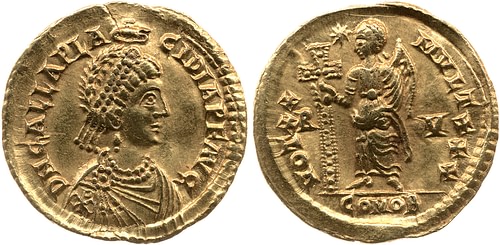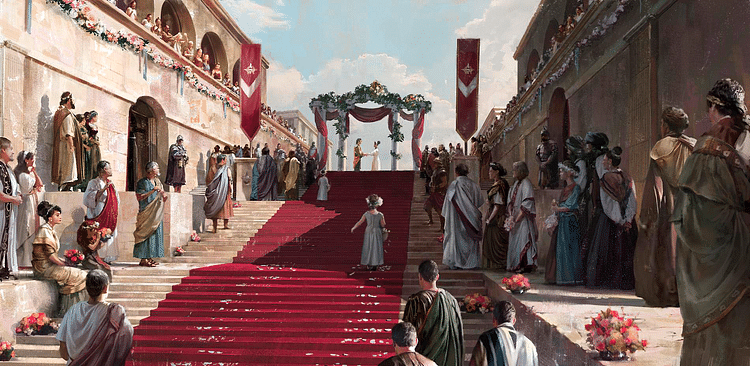
Galla Placidia (388-450 CE), the future empress, was the half-sister of the Westen Roman emperor Flavius Honorius (r. 395-423 CE), and the daughter of Theodosius the Great (r. 379-395 CE). She was taken hostage by Alaric during the sack of Rome 410 CE. After returning to Rome, she became regent for her young son, Honorius' heir, Valentinian III.
Family
Aelia Galla Placidia was born in 388 CE to the Roman emperor Theodosius I and his second wife Galla, sister of the emperor Valentinian II (375-392 CE). The young Galla spent most of her early life in the capital of the Eastern Roman Empire, Constantinople. Galla's two brothers – Honorius and Arcadius (r. 395-408 CE) – were from the emperor's first marriage to Aelia Flavia Flacilla. Theodosius is best remembered for reuniting East and West for the last time and making Christianity the only official religion of the Roman Empire. He banned all other faiths in 392 CE and destroyed all pagan temples. Some blamed the destruction of the pagan temples as a cause for the fall of the Western Roman Empire.
When Theodosius died, the empire was divided between his two sons. Since Honorius was only ten years old, Flavius Stilicho, magister militum, served as his regent. Stilicho unsuccessfully tried to negotiate an alliance with Alaric, the king of the Visigoths, who he had been trained in the Roman army, fighting alongside the Romans at the Battle of the Frigidus in 394 CE. Negotiations, however, failed, and when Alaric became a threat to the imperial family, the capital was moved to Ravenna.
Sack of Rome
Honorius had repeatedly mismanaged relations with the Alaric, so Alaric marched on Rome in 408 CE, surrounding all 13 gates, forcing the Roman Senate to empty its treasury and pay a huge ransom, but the Goths remained in Italy. The ancient city was on its knees, famine reigned, bodies littered the streets. Simon Baker in his book Ancient Rome said: "The city that had ruled the known world, the home of the ancient gods, the Gods of the Christians, and the Senate became a tomb, a desolate, morbid ghost town." (395)
Honorius did little to help the city, and many people blamed the situation on the incompetent Honorius who sat safely in his palace at Ravenna. Alaric waited but to no avail. Negotiations failed again, and with little alternative, Alaric, with his brother-in-law Athaulf, marched on Rome for the third time in two years. On the night of 24 August 410, the Salarian Gates was opened by someone unknown, and the city, with little resistance, was easy to overcome.

Historian Peter Heather in his The Fall of the Roman Empire said: "By all accounts there followed one of the most civilized sacks of a city ever witnessed. Alaric's Goths were Christian and treated many of Roman holiest places with great respect." (227) Alaric had given strict orders to respect churches and monasteries. Although only the old Senate house was burned, the Goths stripped statues and senatorial houses of precious metals and gems. Perrottet wrote that "fighting erupted in many parts of the city and it descended into savagery when Hun mercenaries ran riot" (61).
Alaric left Rome, taking with him the spoils of siege and, surprisingly, the emperor's sister Galla Placidia. She would remain a hostage for almost a decade. Alaric delegated responsibility for Galla to Athaulf and because of her imperial rank, she was treated with respect and was able to maintain a semblance of independence. However, with the death of Alaric in 410 CE, leadership fell to Athaulf, and in 412 CE, he left Italy and marched into Gaul, only to be forced to resettle at Barcelona in Spain.
Marriage to Athaulf
In 414 CE, Athaulf and Galla were married (possibly against her wishes) at Narbonne in southwestern Gaul. Deanesly wrote that they were married without imperial permission as Honorius withheld his consent, although emperors of that era usually had no objections to a marriage between royal houses and barbarian leaders. Athaulf and Galla had one son, Theodosius. Unfortunately, the young heir died shortly after birth and was buried in Barcelona.
In 415 CE, Athaulf was stabbed to death by a resentful servant. The new leader was the anti-Roman Sigeric (Segeric) who had seized power. He killed off all of Athaulf's children from a previous marriage, and with little concern for Galla's imperial rank forced her to march on foot for 19 km (12 mi) in front of other captives. Luckily for Galla, and before he could decide on Galla's fate, Sigeric was murdered after only seven days. The new king Wallia gave in to Roman pressure and entered into negotiations with Rome, and for 600,000 measures (modii) of Roman grain, she was sent home to Honorius.
Marriage to Constantius
After her return to Ravenna, she married (again unwillingly) Honorius' commander Constantius on 1 January 417 CE. It was Constantius who had driven Athaulf into Spain, and while regaining lost territory in Spain and Gaul, Constantius, was also able to subdue the revolt of the self-appointed emperor Constantine III (r. 407-411 CE). The marriage produced two children: a daughter Justa Grata Honoria in 418 CE and a son Valentinian in 419 CE.

Constantius was named co-emperor as Constantius III, possibly against the wishes of Honorius, and with her husband becoming augustus, Galla became augusta. When Galla's nephew, the Eastern Roman emperor Theodosius II (402-450 CE) refused to recognize them, Constantius wanted to force him into recognition but fell ill. Constantius died after only seven months as co-emperor in 421 CE. Two years later, Galla and her children were banished from Ravenna, fleeing to Constantinople. After Honorius died of dropsy, Theodosius finally recognized the future Valentinian III (r. 425-455) as the legitimate heir in the West.
Johannes Seizes the Throne
Before Galla and her son could return to Ravenna, the throne was seized by Johannes (Ioannes), a senior notary or primicerius notariorum. His magister militum, Flavius Castinus was an enemy of Galla and wanted to prevent her from returning to Ravenna and putting her son on the throne. He had supported Honorius during a dispute between Galla and her brother, prior to her banishment. Johannes was recognized by Spain, Gaul, and Italy, and he had hoped to be recognized by Theodosius, but approval was denied.
Galla reacted quickly and convinced her nephew to send an army to Italy. Theodosius' army easily entered Ravenna and routed Johannes' forces, unopposed. He was arrested, condemned to death by Galla, and executed in 425 CE. Valentinian III became emperor, but since he was only six years old, Galla Placidia became the regent.
Galla as Regent
During her regency, three men rose to prominence, challenging each other as to who would have the most influence on the young emperor. Flavius Aetius, commander of the army and later magister militum, had initially been Galla's enemy, supporting Johannes, but Galla felt obligated enough to offer him terms and give him control of the army in Gaul. Next, Bonifacius (Boniface) was commander of the Roman guard and later commander in Africa. Like Aetius, he was initially estranged from Galla but reconciled with her. Aetius and Boniface would meet in battle at Rimini in 432 CE where Boniface was wounded and died. Lastly, Flavius Felix, a self-serving politician, was caught in a plot against Aetius. Aetius had been warned – possibly by Galla – that Felix was plotting against him. Felix was arrested, and he and his wife were both executed. Aetius would go on to achieve success against the Visigoths but was assassinated in 454 CE by the emperor Valentinian III; he was seen as no longer necessary.
As her son's regent, Galla "played generals off on one another, keeping the deadly intrigues of the court in check and building alliances to stem off the new threat of the East, Attila the Hun" (Perrottet, 65). Deanesly maintained that with Honorius' death, "she became for twenty-five years the real ruler of the west" (29). Unfortunately, her children proved to be a major disappointment. Valentinian turned 18 in 437 CE and assumed control of the throne but proved to be as weak as his uncles. His sister Honoria fared no better. She refused to marry a Roman senator, a man of her brother's choosing. Looking for a way out, she sent her signet ring to, of all people, Attila the Hun, asking for him to help her escape her brother's wishes. Seeing it as a marriage proposal, Attila demanded half of Valentinian's kingdom as a dowry. The emperor refused. Attila, who did not take the refusal well, marched into Gaul only to be defeated by Aetius. Seen as treason, Honoria was, by most accounts, banished.
![Attila the Hun [Artist's Impression]](https://www.worldhistory.org/img/r/p/500x600/3047.jpg?v=1628469902)
Galla died in 450 CE and was buried in the family mausoleum. Margaret Deanesly wrote that "Her career is an instance of the awkward mingling of the ruling classes of Roman and barbarian ruling classes and an example of Byzantine willingness to let a woman share in imperial rule" (29).








